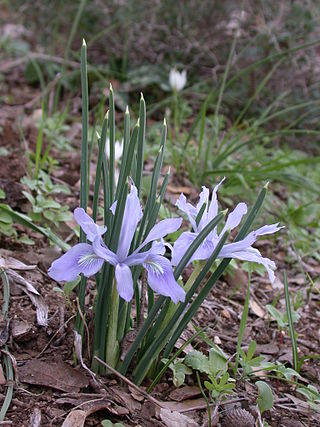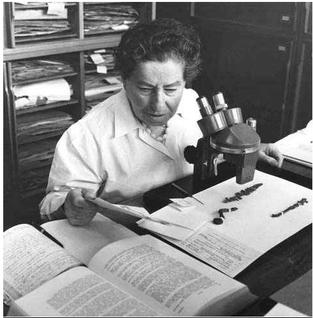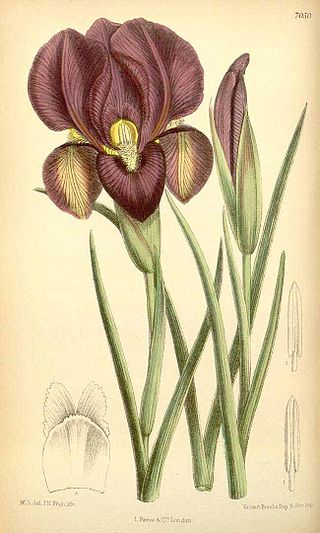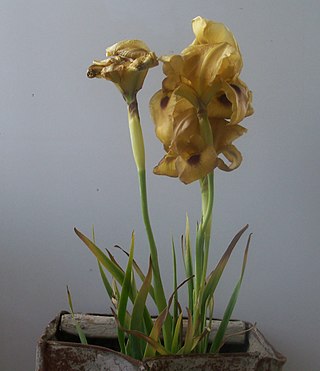
Iris vartanii is a plant species in the genus Iris. It is classified in the subgenus Hermodactyloides and section Reticulatae. It is a bulbous perennial.

Iris palaestina is a species in the genus Iris in the subgenus Scorpiris. It is a bulbous perennial from Asia, including the Palestine region, Lebanon, Syria and Turkey. It has long, narrow, strap-like leaves, and a short stem. The early blooming, fragrant flowers are greenish-grey/white or yellow-white.

Naomi Feinbrun-Dothan was a Russian-born Israeli botanist, who became part of the academic staff at the Hebrew University of Jerusalem. She studied the flora of Israel and published dozens of articles and several analytical flora books. Just after her 91st birthday, she received the 1991 Israel Prize for her unique contribution to the Land of Israel studies.
Iris antilibanotica is a species in the genus Iris, it is also in the subgenus Iris. It is a rhizomatous perennial, from the mountains of Syria. It has semi-evergreen, green, falcate leaves, slender stem, bi-coloured flowers, in dark purple, violet. With a small dark spot and purple tipped yellow beard on the outer petals. It is rarely cultivated as an ornamental plant in temperate regions and thought to be extinct in the wild.

Iris atrofusca is a species in the genus Iris, where it is placed in the subgenus Iris and the section Oncocyclus. It is a rhizomatous perennial from the deserts of Israel and Jordan. The species has long falcate (sickle-shaped) or ensiform (sword-shaped) leaves, a long thick stem and large fragrant flowers that come in shades of purple brown, reddish-black, black-brown, dark brown, dark lilac or dark purple. The flowers also have a black or brownish-black signal patch and a thick beard that is brown-black, light brown or yellow tipped with brown. It is rarely cultivated as an ornamental plant in temperate regions.

Iris atropurpurea, the coastal iris is a species in the genus Iris, it is also in the subgenus of Iris and in the section Oncocyclus. It is a rhizomatous perennial, from Israel. It has glaucous (blue-green), linear, falcate (sickle-shaped) leaves. Between February and March, it has between 1 and 2 flowers, in dark shades from red-brown, burgundy, dark purple to blackish purple. They have a darker signal patch and yellow beard tipped with purple. It is rarely cultivated as an ornamental plant in temperate regions, due to it needing very dry conditions.

Iris barnumiae is a species in the genus Iris; it is also in the subgenus Iris and in the section Oncocyclus. It is a rhizomatous perennial, from Armenia, Azerbaijan, Iran, Iraq, and Turkey. It has pale glaucous green and narrow leaves, that are slightly sickle-shaped and fade soon after blooming. It has, in mid- to late spring, fragrant flowers in shades of purple, from red-purple, mulberry to purplish-violet, with a yellow tipped with purple beard. It was renamed as I. barnumiae in after a plant naming conference in 2011, but is still sometimes named as I. barnumae in some sources. It has one accepted subspecies Iris barnumiae subsp. demawendica and two forms; Iris barnumiae f. protonyma (Stapf) B.Mathew & Wendelbo and Iris barnumiae f. urmiensis (Hoog) B.Mathew & Wendelbo, which has yellow flowers. Sometimes I. barnumiae f. barnumiae is used to describe the basic form. It is rarely cultivated as an ornamental plant in temperate regions, due to its needing very dry and warm summer conditions.

Iris auranitica is a species in the genus Iris, it is also in the subgenus Iris and in the section Oncocyclus. It is a rhizomatous perennial in the Jabal al-Druze region in Syria, where it grows at about 1600 m. It has thin and long, greyish-green, semi-evergreen leaves. In May, it has fragranced flowers, with a dark signal patch and yellow beard with purple tips. It is rarely cultivated as an ornamental plant in temperate regions, as it needs very dry conditions during the summer.
Iris basaltica is a species in the genus Iris, it is also in the subgenus Iris and in the section Oncocyclus. It is a rhizomatous perennial, from the basalt deserts and hillsides of eastern Syria. It has many falcate long leaves, and long stem. Between March and April, it has white or pale green flowers covered in thick purple or black veining and dots or spots. It also has a purple or maroon beard, tipped with yellow. It is rare cultivated as an ornamental plant in temperate regions, due to its environmental conditions of its natural habitat.

Iris bismarckiana, the Nazareth iris, is a species in the genus Iris, it is also in the subgenus Iris and in the section Oncocyclus. It is a rhizomatous perennial, from the mountainsides of Israel, Lebanon, Jordan and Syria. It has stoloniferous, spreading rhizomes, long, sword shaped, bright green leaves, long slender stem and 1 flower in Spring. The large flower is pale yellow, creamy-white, or white background. Which is covered with reddish-brown, maroon brown, purple-brown, purple, blue-purple, or blue veins, markings or spots. It has a dark signal patch and dark purple to black beard. It is rarely cultivated as an ornamental plant in temperate regions, as it needs very dry conditions during the summer.

Iris bostrensis is a species in the genus Iris, it is also in the subgenus Iris and in the section Oncocyclus. It is a rhizomatous perennial, from the border between Syria and Jordan. It has greenish-grey leaves, 1–2 flowers in Spring,, which have a yellowish, greenish or pale brown ground, which is then covered in many brown-black, brown-purple, or brown, spots, streaks or veining. It has a bright yellow beard, slightly tipped in purple. It is rarely cultivated as an ornamental plant in temperate regions, due to its environmental conditions of its natural habitat.
Iris cedreti is a species of flowering plant in the genus Iris; it is also in the subgenus of Iris. It is a rhizomatous perennial endemic to Lebanon. It has long narrow leaves, short stem, and flowers with a white background which is covered with very small dots or veins of dark maroon, purple, purplish-maroon, or almost black. It has a dark maroon signal patch with a brownish or purplish beard. It is rarely cultivated as an ornamental plant in temperate regions, as it needs very dry conditions during the summer. It is listed as critically endangered by the IUCN.

Iris haynei, the Gilboa iris, is a plant species in the genus Iris, subgenus Iris and section Oncocyclus. It is a rhizomatous perennial, from the shrublands and mountainsides in Palestine and Israel, in the Gilboa mountain. It has smooth, linear or lanceolate, greyish-green leaves. Long slender stem and in Spring, large, fragrant flowers in shades of deep purple, violet, purple, brownish purple or dusky lilac veining or speckling over a pale ground. It has a dark purple, black-brown, to blackish signal patch, and a beard, which is variable from dark purple, white, or dark tipped yellow. It is rarely cultivated as an ornamental plant in temperate regions, as it needs very dry conditions during the summer.

Iris hermona, the Golan iris, is a plant species in the genus Iris, it is also in the subgenus of Iris, and in the section Oncocyclus. It is a rhizomatous perennial, from the pastures and meadows of the Golan Heights in Israel and Syria. It has linear, upright leaves, tall slender stem holding a bi-coloured flower, having a pale lilac, cream-yellow, light tan, or white background, which is then covered in purple brown, or purple, or purple-pink veining, spots or speckling. It has a round purple-brown or almost black signal patch, and a sparse purple brown or almost black beard. It is rarely cultivated as an ornamental plant in temperate regions, as it needs very dry conditions during the summer.
Iris heylandiana is a species in the genus Iris, it is also in the subgenus Iris, and in the section Oncocyclus. It is a rhizomatous perennial, from the marshlands or fields of Iraq. It has short, linear or sickle shaped grey-green leaves, slender stem, a single flower in spring, which has a dingy-white, whitish, or pale background, which is covered in many spots or dark veining, in black-purple, brown-purple, or brown violet, or brown shades. It has a dark brown or burgundy brown signal patch and white tinged with yellow or orange white sparse beard. It is rarely cultivated as an ornamental plant in temperate regions, as it needs very dry conditions during the summer.

Iris iberica subsp. elegantissima is a subspecies in the genus Iris, subgenus Iris and section Oncocyclus. It is a subspecies of Iris iberica and is a rhizomatous perennial, from Armenia, Turkey and Iran. It has large, thin and falcate (sickle-shaped) leaves, slender stem with a single flower between April and May. It has a white, cream or pale yellow ground, which is covered in dark veining or speckling in violet, mauve, purple or brown shades. The larger standards are paler, normally white and less veined. The falls, have darker veining and a dark signal patch and brown or purple beard. It is commonly known as Iris elegantissima, especially in Europe and Russia. It is cultivated as an ornamental plant in temperate regions, but normally needs some protection during the winter period.

Iris mariae is a species in the genus Iris, it is also in the subgenus Iris and in the section Oncocyclus. It is a rhizomatous perennial, from the deserts of Israel and Egypt. It is fairly tall, with long and slender glaucous leaves, and in late spring, lilac-purple to pinkish or violet flowers with deeper veining and blackish-violet signal and dark purple beard.

Iris lortetii is a species in the genus Iris. It has straight grey-green leaves, a 30–50 cm tall stem, and large showy flowers in late spring or mid-summer that come in shades of pink, from white, lilac, pale lavender and grey-purple. It is veined and dotted pink or maroon. It has a signal patch that is deep maroon and a sparse and brown, purple-brown or reddish beard.
Iris westii is a species in the genus Iris, it is also in the subgenus of Iris and in the Oncocyclus section. It is from the mountain sides of Lebanon. It has curved grey-green leaves, a stem carrying one flower in shades of lilac, white or beige with spotting or veins in a darker shade or violet. The lower petals have deep velvety chocolate or deep violet-black signal patch and a purple beard. It rare and threatened due to habitat destruction, from military actions, overgrazing by goats and other factors.
















